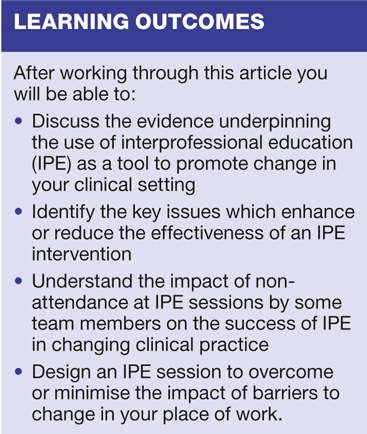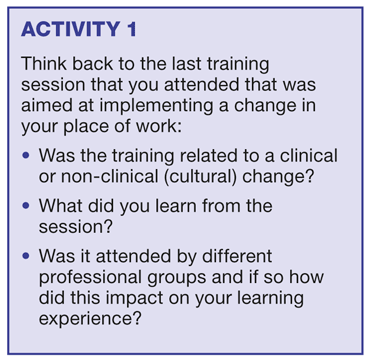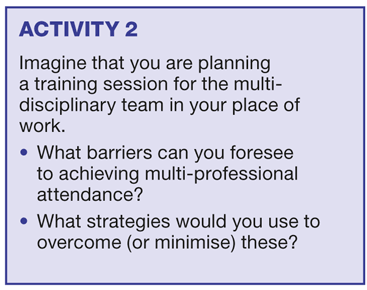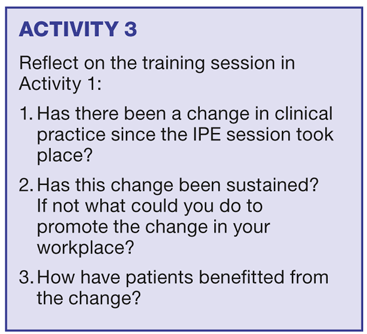Interprofessional education: Facilitating change in clinical practice
Yvonne Henderson
Yvonne Henderson
(MSc Physiotherapy)
Academic Lead, Education for Health, Warwick
The provision of high quality healthcare needs an appropriately trained workforce. Interprofessional education has been identified as one method by which changes to clinical practice can be brought about
It has long been recognised that the continuing education of healthcare professionals is essential for the maintenance and progression of quality healthcare services. Approximately £4.9 billion is spent annually on healthcare education programmes throughout health and public health services,1 with the aim of developing a competent workforce with the flexibility and skills to adapt to the ever-changing NHS environment.
Interprofessional education (IPE) is defined as: '...occasions when two or more professions learn together with the object of cultivating collaborative practice.'2
It encourages collaboration between healthcare professionals, aims to help improve healthcare services and, ultimately, to bring about change in clinical practice and working strategies.1 It has been a continuing theme through successive government policy documents relating to the delivery of quality care. The role of IPE in continuing professional development has been highlighted as an integral component in the modernisation of the NHS,3 and recognised as a tool to improve cross-boundary and cross-organisational working.
As the NHS evolves, so too does the evidence base for interventions. Transferring research findings into clinical practice however, is a slow process and the uptake is variable and haphazard.4 Collaborative working has a role in promoting communication, team working and respect between participants,5 which in turn may facilitate the integration of evidence into healthcare provision. Despite the indications for the role of IPE within the health service, there remains a lack of clarity as to the extent to which it is able to influence clinician behaviour.
This article examines the literature relating to IPE in a healthcare setting and the key components that can improve the success of inter-professional learning, including:
- Using IPE to overcome the barriers to change in clinical practice
- The impact of non-attendance by some team members
- The impact of healthcare professionals' perceptions about IPE.
It aims to highlight the factors that are important in promoting successful IPE and identifies ways in which these can be incorporated into day-to-day practice.
AVAILABLE EVIDENCE
Despite IPE being portrayed in a range of policy documents as a valuable and effective tool to promote changes in clinical practice, the quality of the underpinning evidence is limited. Only a small number of robust studies are available.
The complex nature of evaluating behavioural change and relating this specifically to a single intervention is notoriously difficult. Changes in practice are influenced by a broad range of factors, such as organisational culture, external policy drivers or patient health beliefs, all of which can facilitate or hinder a change in practice. This makes designing research studies to evaluate the impact of an educational intervention challenging. As a result, the available evidence covers a broad range of interventions in a variety of clinical settings using a range of outcome measures. This makes comparison and assimilation of results difficult and limits our ability to generalise any findings.
Consequently, the evidence base for recommendations is relatively weak. However, even in the absence of high quality evidence, the results of the available studies are still helpful in identifying ways to maximise the impact of IPE. These themes, which should be considered by practitioners involved in the design, delivery or attendance at IPE sessions, will be discussed in more detail.
OVERCOMING BARRIERS
The process of changing clinical practice is well recognised to be complex. The most common barriers to implementing change are time, workload and resistance from colleagues.5 Implementation of change can be undermined by a lack of understanding of others' roles, poorly co-ordinated teamwork and poor communication.6 Strategies to overcome any or all of these barriers are valuable and IPE has been shown to be a useful intervention in this regard. It can promote and develop communication between colleagues,5 encourage sharing of resources,5,7 and increases the ability of participants to influence change in their area of work.6 This ability to influence change stems from a feeling of being more valued and supported by colleagues, which in turn promotes confidence and self-belief.
IPE not only enables the individual to develop the skills to promote change, it is also recognised as being effective in promoting change within the organisation.5 This is achieved by developing skills within the team6 and enhancing positive attitudes and respect between different professional groups.8 IPE is recognised as being a significant factor in assisting practitioners to implement change in their workplace, by encouraging communication and openness between colleagues, thereby reducing the impact of resistance to change.5,6
Sustainability of change is variable; in studies this ranged from 8 to 21 months.6,7 The changes to individual participants and the wider organisation are often immediate and relate to specific areas of practice. IPE builds on the confidence and self-belief of the participants, leading to short-term change. Changes to practice are more easily sustained while feedback is continued, but without on-going reinforcement a sustained change is less likely.
It should however be noted that IPE which focuses on a system-change (i.e. a change to the culture or processes within an organisation) has been shown to improve attitudes among staff and more consistently results in a sustained change to practice.5 This would suggest that IPE interventions that focus on cultural changes may be more successful than those that focus purely on clinical content.
NON-ATTENDANCE
The factor most detrimental to the success of an IPE intervention is non-attendance by some members of the team.5,8 Non-attendance reduces the ability of the rest of the team to implement change in clinical practice and consequently limits the success of the intervention. It is thought that the most common reason for this effect is a perceived lack of support for future change from the colleagues who did not attend.8
The level of impact of non-attendance is varied, according to which professional groups were absent. It is of particular concern that proportionately fewer medical professionals attend IPE sessions compared with other professional groups. Medical professionals are often considered to be key to enabling subsequent change and their lack of engagement in IPE has a detrimental effect on its success. This would suggest, therefore, that successful IPE is dependent upon engagement by the whole team and that the outcomes are compromised by non-attendance of key decision makers (or those perceived as being key decision makers), regardless of their profession.
HEALTHCARE PROFESSIONALS' PERCEPTIONS
Perceptions of the value of IPE vary between healthcare professional groups.5 Medical staff report less engagement with the sessions and reduced likelihood of recommending such initiatives to their colleagues. There is a belief that IPE can be used as a mechanism for 'dumbing down' and merging professional groups, with the potential that health professionals may view it as a threat to their professional role, or a way of cost saving. Healthcare professionals' perceptions may also be influenced by the attitude of their professional body.9 Concern exists that IPE could erode the professional autonomy that individual disciplines have been working to attain.
The importance of providing a good learning experience for participants undertaking IPE cannot be underestimated. Previous experiences will shape expectations and perceptions and will impact on engagement with future IPE sessions. An unsatisfactory learning experience is not only unlikely to deliver the intended message, but it is also unlikely to promote behavioural change. A poor experience, by promoting negative feelings associated with particular professions or changes, could do more harm than good. Such negative perceptions can be carried over into clinical practice and become a barrier to future collaborative working.
Although the success of IPE can be limited by preconceptions and past experiences, when IPE is well designed, its great strength is its ability to promote and facilitate understanding between professions of different ways of thinking and working, and different approaches to care.
TRANSLATING KNOWLEDGE INTO CLINICAL PRACTICE
IPE is recommended as an integral tool to enable healthcare professionals to provide high quality care. The strength of this recommendation is however limited by the lack of robust research.10 While it has been shown to result in a change in knowledge and skills with a subsequent change in clinician behaviour,5-7 how this translates to a change in clinical practice and improvements in clinical care is less clear. Self-reported improvements in clinical skills have been identified following IPE, although this does not always correspond to an improvement in patient satisfaction scores.11
The impact of IPE on clinician adherence to guidelines and subsequent change in practice is limited.7,8 This is despite participants reporting a positive experience of the educational sessions. It is therefore important, when considering an evaluation of the impact of such an educational programme, that it should be judged on its impact on patient care, rather than simply on the self-reported beliefs of the participants.
It is also clear from the literature that the success of an IPE intervention can be improved by ensuring that the educational intervention is specific and targeted. This is a key factor in the degree of the transfer of skills into clinical practice. It has been shown that specific training in one targeted area can lead to an improvement of skills in that area, but these changes are not readily transferred into other areas of care.5,7
Providing IPE that is more general and aimed at enhancing patient-centred care leads to a better understanding of the necessary competencies, but there is limited evidence of this translating into a change in clinical practice or change to the appropriateness of care given. Conversely, in specific clinical areas, such as emergency departments, IPE can result in a significant improvement in team working which, by reducing the clinical error rate, corresponds to improved care for patients.6
These observations highlight the need for IPE interventions to focus on specific areas of clinical practice or organisational culture, and to be evaluated by their impact on patient care, rather than solely on feedback from participants.
CLINICAL IMPLICATIONS
The complexity of healthcare provision and the shift away from acute care to chronic disease management has the potential to make delivery of high quality care more difficult. The range of health and social care professionals and agencies involved in delivering care, from primary care, secondary care and the community setting, means that inter-professional working is, by necessity, a core component of healthcare delivery. The success of IPE is heavily dependent on participation of all members of the team, and its outcomes will be, to some extent, dictated by the attitudes and preconceptions of the participants.
IPE provision should be clearly focussed and targeted to the participants and their needs in order to maximise the opportunity to translate learning into clinical practice.
It is important to be realistic in your expectations of what can be achieved in a single teaching session. Changing practice may not be possible following short interventions as these may not give sufficient support to enable change in the workplace to be effected. Sustained change requires on-going follow up and management.
CONCLUSION
Although there is an absence of good quality evidence, the available research shows that IPE has a positive impact on enabling practitioners to overcome some of the barriers to change, and assists them in the transfer of knowledge and skills into clinical practice. The available evidence suggests that IPE can improve certain aspects of health professional working practices and can lead to changes in behaviour and consequent changes to clinical practice in specific clinical scenarios.
The evidence also highlights that the success of IPE as a tool to promote change is dependent upon healthcare professionals' perceptions of IPE, with negative perceptions resulting in less engagement and fewer measurable changes to practice. Non-attendance by team members is a significant factor in reducing the effectiveness of IPE interventions.
The absence of evidence does not in itself imply the IPE is an ineffective tool for changing clinical practice, but may simply be an indication of the complexities of evaluating both the intervention, and the outcome measures in a sufficiently rigorous way.
SELF-ASSESSMENT Q&A
1.True or False? The evidence base for Inter-professional education is of a high quality and clearly identifies the impact of IPE on clinician behaviour
False: The evidence base is growing, but lacks high quality, robust studies.
2.True or False? Well designed Inter-professional Education is an effective method of promoting collaborative working between the different professions.
True: The evidence clearly links IPE with effective collaborative working
3.Which of the following are recognized as being the main barriers to changing clinician behavior:
a.Time
b.Cost
c.IT systems
d.Resistance from colleagues
e.Workload.
a., d.,e.
4.True or False? Inter-professional Education is shown to improve communication and promote respect between team members.
True.
5.True or False? Members of the medical profession are highly likely to support Inter-professional Education Interventions in their area of work.
False.
6.True or False? Non-attendance by some team members has little impact on the outcome of an Inter-professional Education session.
False.
7.True or False? Professional bodies can perceive Inter-professional Education as a threat to professional autonomy.
True.
8.True or False? A good learning experience will increase the likelihood of successful change in clinician behavior.
True.
9.True or False? The new skills and knowledge learnt during an Inter-professional Education session are easily transferred into other areas of care.
False.
10.Which of the following are key components of a successful Inter-professional Education intervention:
a.Specific, targeted content
b.Nice biscuits and fresh coffee
c.Attendance by all team members, particularly those perceived to be key decision makers
d.The session being led by the most senior member of staff present
e.All attendees having a specific interest in the topic being discussed
f.Provision of a good learning experience.
a., c.,f.
REFERENCES
1. Department of Health. Liberating the NHS: Developing the Healthcare workforce - From Design to Delivery. DH 2012 http://www.dh.gov.uk/en/Publicationsandstatistics/Publications/PublicationsPolicyAndGuidance/DH_132076
2. Barr H et al. Interprofessional education 1997 - 2000: A review. CAIPE: London. 2000
3. Department of Health. The NHS improvement plan: Putting people at the heart of public services. DH 2004 http://www.dh.gov.uk/en/Publicationsandstatistics/Publications/PublicationsPolicyAndGuidance/DH_4084476
4. Hall P, Weaver L. Interdisciplinary education and teamwork: A long and winding road. Med Educ 2001;35:867-875.
5. Campbell JC, Coben JH, McLoughlin E, et al. An evaluation of a system change training model to improve emergency department response to battered women. Acad Emerg Med 2001; 8 (2): 131-8
6. Morey JC, Simon R, Jay GD, et al. Error reduction and performance improvement in the emergency department through formal teamwork training: evaluation results of the Medteam project. Health Serv Res 2002; 37(6):1553-81
7. Thompson RS, Rivara FP, Thompson DC, et al. Identification and management of domestic violence: a randomized controlled trial. Am J Prev Med 2000;19(4218): 253-63
8. Young AS, Chinman M, Forquer SL, et al. Use of a consumer led intervention to improve provider competencies. Psychiatr Serv 2005;56(8):967-75
9. Barr H, Koppel I, Reeves S, et al. Interprofessional Education: assumption, argument and evidence. London, Blackwell. 2005
10. Zwarenstein M, Reeves S, Barr H, et al. Interprofessional Education: effects on professional practice and health care outcomes. Cochrane Database Syst Rev 2000;3 [DOI:10.1002/14651858.CD002213]
11. Brown JB, Boles M, Mullooly JP, Levinson W. Effect of clinician communication skills training on patient satisfaction: a randomized controlled trial. Ann Intern Med 1999; 131(11): 822-9
Related articles
View all Articles





